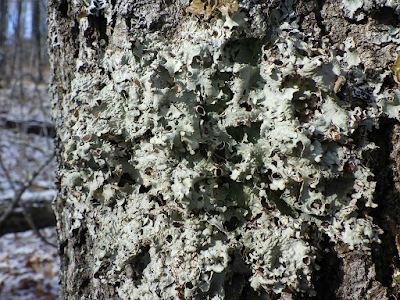Creeping Charlie Biocontrol
I spent a few days back in Murdock this week. While most of my time was spent hanging out with family, of course I was given the task of mowing lawns and weeding flower beds. Last year I planted a variety of flowers on the south side of the garage (maximillian sunflower, ironweed, spiderwort, baptisia, sand cherry, narrow-leaved coneflower, and hoary vervain). They were mostly overrun (although the sunflowers were standing tall and proud over everything) by non-native weeds that started growing through the mulch - lawn grasses, curly dock, and prickly lettuce. After quite a bit of pulling, it was looking pretty good and it became apparent that all the plants survived the winter. I'm sure they'll also be happy, freed from competition for light water, and nutrients, even if for only a few weeks before the weeds return.
I finally thought that I was done, but across the ground another non-native, creeping Charlie, was dominating. While the stems are easy to pull and break off with almost no effort, the roots are extremely difficult to get out. I knocked them back, but with the roots mostly intact, I'm guessing that they'll return in full force in no time at all. Hopefully over time the natives will continue to add more shade and take up more space/resources and slowly outcompete the creeping Charlie.
While pulling the stems I noticed a few species that might help control this population much better than my weeding it every now and then. The first one is Ground-ivy rust (Puccinia glechomatis). I first noticed this species last year at Camp Lake and this was my second time seeing it. According to this paper this species was first documented in MN in 2020 in the Twin Cities area. I'm guessing it's been around for a while longer than that, but its good to know that its in other parts of the state. According to that study it's deleterious impact on the plant is variable, causing leaf loss from 1-30%. By no means perfect control, but 30% is pretty significant. The other species is the glechoma gall wasp (Liposthenes glechomae). After many hours of my life weeding creeping Charlie, this was my first time seeing this species. Which was surprising being how many galls I found, around 20. Whether that is because it just made its way to this area, had a really large population this year, or I just never noticed it before, I cannot say. Most gall-forming species have an insignificant impact on the health of their host; if they are on the seeds/flower in large outbreaks they can reduce population sizes by more. This species is found on the leaf, petiole, and stem, so I would guess it has very little impact on creeping Charlie populations. And the plants that were galled seemed very healthy with many flowers. But agin, a little control of non-natives is better than none. One of the reasons non-natives are so detrimental is they outcompete natives and have few ecological relationships. So, they add to the food web very little. I'm guessing that there is something out there that acts as a predator to these wasps. Even if they don't control the creeping Charlie much, at least they add to the food web. Hopefully both species continue to spread and increase their populations to reduce the populations of creeping Charlie in the years to come, even if by just a little. I made sure to leave the plants that were infected so these species could complete their lifecycle and do just that.
While pulling the stems I noticed a few species that might help control this population much better than my weeding it every now and then. The first one is Ground-ivy rust (Puccinia glechomatis). I first noticed this species last year at Camp Lake and this was my second time seeing it. According to this paper this species was first documented in MN in 2020 in the Twin Cities area. I'm guessing it's been around for a while longer than that, but its good to know that its in other parts of the state. According to that study it's deleterious impact on the plant is variable, causing leaf loss from 1-30%. By no means perfect control, but 30% is pretty significant. The other species is the glechoma gall wasp (Liposthenes glechomae). After many hours of my life weeding creeping Charlie, this was my first time seeing this species. Which was surprising being how many galls I found, around 20. Whether that is because it just made its way to this area, had a really large population this year, or I just never noticed it before, I cannot say. Most gall-forming species have an insignificant impact on the health of their host; if they are on the seeds/flower in large outbreaks they can reduce population sizes by more. This species is found on the leaf, petiole, and stem, so I would guess it has very little impact on creeping Charlie populations. And the plants that were galled seemed very healthy with many flowers. But agin, a little control of non-natives is better than none. One of the reasons non-natives are so detrimental is they outcompete natives and have few ecological relationships. So, they add to the food web very little. I'm guessing that there is something out there that acts as a predator to these wasps. Even if they don't control the creeping Charlie much, at least they add to the food web. Hopefully both species continue to spread and increase their populations to reduce the populations of creeping Charlie in the years to come, even if by just a little. I made sure to leave the plants that were infected so these species could complete their lifecycle and do just that.
Ground-ivy rust (Puccinia glechomatis)




Comments
Post a Comment